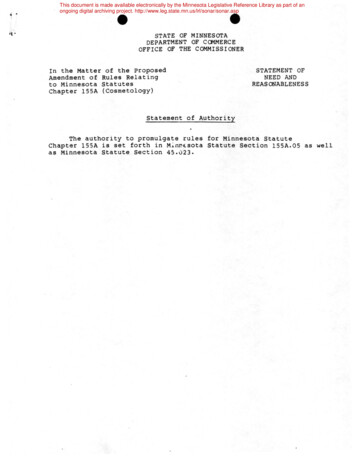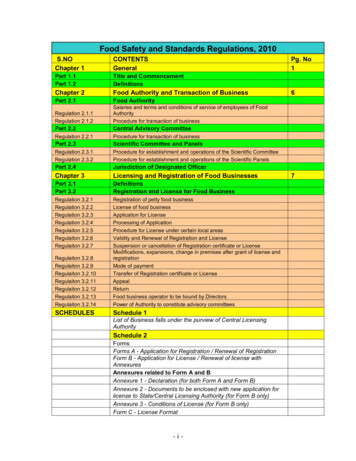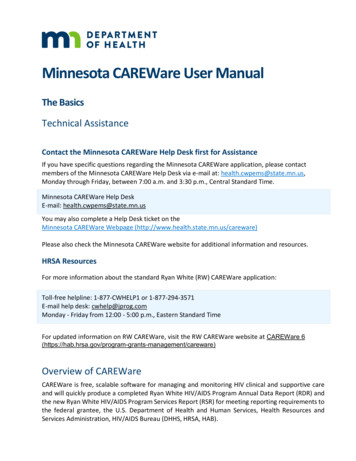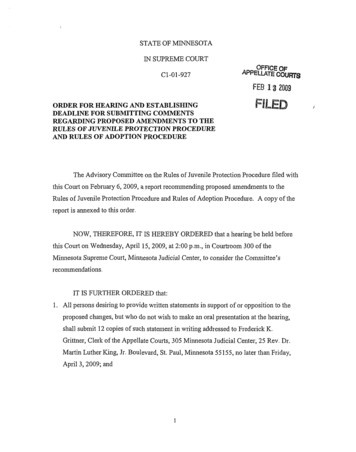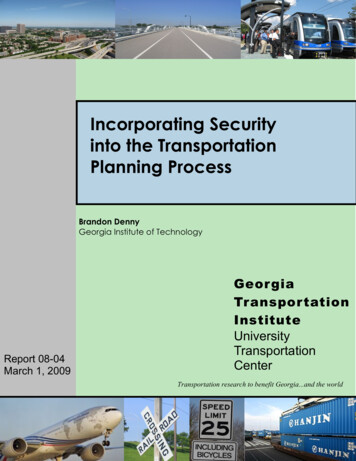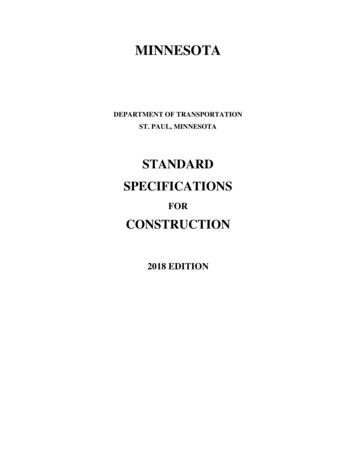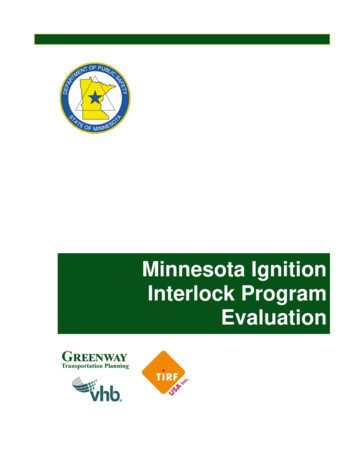
Transcription
School TransportationRegulationJanuary 2020OverviewThis brief outlines various Minnesota Statutes governing school-related transportation. Theregulatory structure under state law can be categorized into a few areas: driver qualifications such as driver licensing, background checks, and drug testingtraining for both drivers and the pupils being transportedvehicle registration and taxation along with tax exemptionsvehicle and equipment standards like light systems, color, and vehicle inspectionspassenger restraints for transporting studentstraffic regulations specific to pupil transportationloss of driving privileges due to various incidents and convictionsA number of requirements vary depending on the circumstances of the transportation. Thatis, different regulations might apply depending on (1) the specific vehicle used, (2) whetherthe transport is to and from school (e.g., on routes with school bus stops) or is for schoolrelated activities (such as a sports event), and (3) whether the driver is employed specificallyin order to transport students.The brief is divided into three parts. First, two tables summarize school-relatedtransportation regulations. One presents the types of vehicles used in school transportation,which consist primarily of traditional school buses of various size and passenger automobiles.The other table outlines some of the regulations that apply for each type of vehicle used inthe transport. Second, the bulk of the brief provides a review of regulations, beginning withthe general context and some definitions. Finally, an appendix provides a summary ofrelevant legislative activity in recent years.ContentsVehicle Classifications Summary Table . 2Regulations Summary Table . 3Pupil Transportation Context. 4School District Powers and Duties . 6Minnesota Regulations . 7Appendix: Recent Law Changes . 23By Matt Burress, matt.burress@house.mnTim Strom, tim.strom@house.mn
School Transportation RegulationVehicle Classifications Summary Table 1VehicleTypeDescription2017-18Fleet 2ASmallest of the traditional yellow school buses, built ona cutaway front-section chassis, with a passengerentrance door behind the front wheels and a separateleft-side driver’s door. They are further divided intotype A-I buses and type A-II buses based on vehicleweight (at 14,500 pounds).BModerate-sized bus built on a stripped chassis, with apassenger door located behind the front wheels. Theyare further classified into type B-I and type B-II based onweight (at 10,000 pounds).268CLarge conventional school bus common throughoutMinnesota. The engine is located in front of the driverand the entrance door is behind the front wheels. It canbe built on a chassis with a hood assembly, or on acutaway truck chassis or truck chassis with a cab havinga gross vehicle weight greater than 21,500 pounds.8,757DLarge, transit-style bus with an entrance door in front ofthe front wheels. The engine is not located in front ofthe windshield, and is often in the rear.1,458IIIA passenger automobile (including minivans, SUVs, andstation wagons), van, or in some cases a vehiclecommonly considered a school bus. It must have (1)capacity for ten or fewer people including the driver,and (2) a maximum weight of 10,000 pounds. See page8.6,293MFSABA “multifunction school activity bus” (MFSAB) is aschool bus that lacks some features specific to otherschool buses. See page 7.MotorcoachA motor coach is not a school bus and is not specificallydefined in state statute. Generally it has an entrancedoor in front of the front wheels, storage capacityunderneath the passenger seating area, separatedseats, and an upgraded interior.1Images sources: http://busspecifications.com; http://www.vanandcardesks.com; http://online.wsj.com;http://www.coachne.com; http://www.schoolbusfleet.com; 2Counts include school district and contractor-owned vehicles in Minnesota. Additional data is available ataTopic.jsp?TOPICID 47Minnesota House Research Department1,624740Page 2
School Transportation RegulationRegulations Summary TableCategoryGeneral PupilTransportationTransportation forActivitiesSmaller Vehicle PupilTransportationVehiclesType A, B, C, or D schoolbus or MFSABType A-I school bus orMFSABiAllowed forms oftransportationTo and from school,except in MFSAB; foractivitiesFor activities only (not to To and from school; forand from school)activitiesDriver’s employment Not specifiedstatusCannot be employedsolely for pupiltransportationType III vehicleEmployed by school orbus contractorMinimum class ofdriver’s licenseClass C, B, or A with both Can be class Dschool bus and(depending on vehiclepassenger endorsements weight & capacity)Class D with noendorsementPhysical examRequiredRequiredMight be requirediiLicense verificationAnnualAnnualAnnualBackground checkRequiredRequiredRequiredPre-employmentdrug testingRequiredNoneMight be requirediiDrug and alcoholtestingRequiredIf employer requiresMight be required bystatute or employeriiDriving incident notification to employer:By employeeRequiredNoneRequiredBy courtsOn certain offensesOn certain offensesOn certain offensesRemoval of drivingprivilegesOn certain offensesOn certain offensesOn certain offensesDriver trainingAnnualAnnualAnnualMust be owned, leased,or contracted by schoolMust be owned, leased,or contracted by schoolAnnualAnnualRequired for each dayRequired for each dayCell phones; stop-armand lighting systemsPupil loading /unloading; cell phonesOwnership of vehicle Not specifiedVehicle inspections:By State PatrolAnnualBy driver (pretrip) Required for each dayRestriction highlights Cell phonesNotesThis set of regulations applies to MFSABs that are equivalent to type A-I school buses in size and capacity.This is required except that employees of a school are exempt if not hired solely to drive type III vehicles. Minn.Stat. § 171.02, subd. 2b.iiiMinnesota House Research DepartmentPage 3
School Transportation RegulationPupil Transportation ContextTypes of Student TransportationStudent transportation takes place in various circumstances. Despite the variety, schooltransportation can be divided into two basic types. They are (1) “to and from” transportation,which refers to transporting students to school and back to their homes or a drop-off/pickuplocation, and (2) “point-to-point” or “activities” transportation, which refers to transportingpupils to educational activities or school-related programs. To and from transport generallyoccurs on a regular schedule and fixed route, whereas point-to-point transportation is morelikely to be occasional.Transportation is provided by school districts, private school bus contractors, nonpublicschools, private and public preschools, and other childcare providers. Employees of theseorganizations who drive may do so professionally (working full-time as a driver), have someamount of driving as part of the person’s job role, or perform driving as an incidental oroccasional part of the job. Examples include: an employee of a private bus company who transports students to and from schooldaily, under contract with a school district;a school district employee who is the primary person providing transportation tospecial events, which is done as part of his or her regular job duties; anda teacher or coach taking a few students in a van to an event, whether regularlythroughout the school year or on occasion.Jurisdiction and ApplicationThe state of Minnesota has primary jurisdiction over school bus equipment, safety, operations,inspections, school district auditing, and driver licensing. The structure of state regulationsapplies when a school (directly or through a bus contractor) provides transportation to itsstudents, including when transporting pupils to and from home as well as for activities such assports and academic trips. State statutes governing pupil transportation do not typically draw adistinction among public schools, school districts, charter schools, and traditional nonpublicschools (e.g., private parochial schools). (Unless otherwise noted, the laws apply to all types ofschools.)Multiple state agencies are involved in pupil transportation policy and enforcement. The Department of Public Safety is designated in statute as having primaryresponsibility over school transportation safety, which is through an Office of PupilTransportation Safety in the State Patrol. Minn. Stat. § 169.435. The Department of Education administers transportation-related state funding toschool districts and is involved in various school district transportation operationsand policy matters.Minnesota House Research DepartmentPage 4
School Transportation Regulation Driver licensing is handled by Driver and Vehicle Services in the Department of PublicSafety, which oversees any required knowledge and road tests, and establishesconditions for physical exams and background checks.The state’s role in school transportation oversight preempts policies set by school districts, butthe districts can establish additional requirements, procedures, and administrative details (suchas in setting busing routes).There are federal regulations as well, which mainly apply to vehicle manufacturers (establishingvarious vehicle design and engineering standards) and commercial driver’s license holders(covering things like limits on the number of traffic tickets a bus driver can get before acommercial driver’s license is suspended, and drug and alcohol testing for such drivers).Restricted Use of School Buses for General TransportationState statutes limit use of traditional yellow school buses to only pupil transportation, althoughthere are exceptions for some situations. This restriction is in effect based on how a vehicle ispermitted to be equipped if it is not used to transport students. Namely, a vehicle originallymanufactured as a school bus that is not actually used as a school bus or Head Start bus cannot: bear a “school bus” sign;be painted yellow; orbe equipped with school bus-related equipment (which likely includes the stop-armand lighting systems). Minn. Stat. §§ 169.441, subd. 3; 169.448, subd. 1.There are exceptions to the equipment and appearance limitations when (1) the vehicle isowned by or under contract to a school district and operated as a charter or leased bus; (2) thebus is used under contract with a tax-exempt entity for a special event and in conformance withmotor carrier regulations; (3) the bus is operated by a day activity center and a specified set ofconditions are met; or (4) the bus is operated by a licensed childcare provider and someadditional conditions are met. Minn. Stat. §§ 169.011, subd. 71 (a); 169.4475; 169.448, subd. 1.Buses used by childcare providers under the exception must: have the stop-arm removed;have the lighting systems deactivated;be identified as a “childcare bus” on the front and rear; andhave the name, address, and phone number of the provider on the vehicle door.Minn. Stat. § 169.448, subd. 1.There also are driver-related requirements for operation of childcare provider buses (which arebased on the prerequisites for some drivers of type A-I school buses). 33The driver regulations are that: the bus operator is not solely hired to provide transportation; the transport is not“to and from” residences and the school or childcare center; the employer (e.g., childcare center or bus transportcontractor) has a program for operator training and certification; the driver has a physical examination; there is aMinnesota House Research DepartmentPage 5
School Transportation RegulationSchool District Powers and DutiesMandatory TransportationMinnesota law requires school districts to transport any student to and from school if thestudent lives more than two miles from the school. Minn. Stat. § 123B.88, subd. 1. A schooldistrict is also required to provide equal transportation for nonpublic school children residing inits district boundaries. However, there are exceptions, such as when a student’s eligibility toride has been revoked.A charter school is subject to the same two mile mandate as school districts for its studentswho live within the borders of the school district where the charter school is geographicallylocated. A charter school may choose to (1) provide transportation itself, or (2) require theschool district where it is geographically located to provide this service and forgo relatedfunding. Minn. Stat. § 124E.15.State law requires school districts to provide additional transportation services under othercircumstances, including: to a student with a disability when included in the student’s individualized educationprogram (IEP);to a nonresident pupil who attends a school in the district through open enrollment,providing transportation from the serving district’s border to the school beingattended; andto a resident pupil attending a charter school that is located within the district, if thecharter school has declined to provide transportation services to its students.Districts have discretion to provide transportation services beyond the minimum set in statestatutes, such as within the two-mile radius or for extracurricular activities. A school districtcan provide pupil transportation services by operating its own fleet of school buses, contractingwith a private vendor, or using a combination of district-operated and contracted services.For more information on funding and fees related to pupil transportation, see the MinnesotaHouse Research Department’s Minnesota School Finance guide.School Bus Routes and StopsMinnesota Statutes grant substantial authority to the board of a school district or charterschool to oversee the logistics of pupil transportation. The statute states:“When transportation is provided, scheduling of routes, establishment of thelocation of bus stops, manner and method of transportation, control anddiscipline of school children, the determination of fees, and any other matterbackground investigation; the driver’s license is annually verified; the driver has not been recently convictedof various automotive and DWI-related offenses; and the driver is trained on use of child safety restraints.Minn. Stat. §§ 169.448, subd. 1; 171.02, subd. 2a.Minnesota House Research DepartmentPage 6
School Transportation Regulationrelating thereto must be within the sole discretion, control, and management ofthe board.” Minn. Stat. § 123B.88, subd. 1.This is the general authority schools rely on when setting bus schedules and locating school busstops. However, the authority is further constrained by both state statute and administrativerule to ensure that school buses do not stop to load or unload students in locations that couldendanger students. For instance, school buses must load and unload on the right side of theroad, and there is a general prohibition on loading or unloading students in a right-turn laneunless specific conditions are met.4 Minn. Stat. § 169.443, subd. 2; Minn. Rules parts 7470.1000,7470.1100.Minnesota RegulationsThis section reviews a variety of safety regulations governing school-related transportation,focusing on relevant definitions, driver qualification requirements, training, equipmentstandards, and special traffic regulations. The requirements and regulations for Head Start busdrivers and buses operated by childcare providers are generally the same or similar, but somedifferences are not discussed.Definitions and ClassificationsSchool BusesState law categorizes school buses as type A, B, C, or D, and it defines two additional specialclassifications of vehicles used to transport students: multifunction school activity buses andtype III vehicles. Minn. Stat. § 169.011, subd. 71. The type A to D buses comprise what istraditionally considered a school bus; key characteristics include a yellow color, markingsindicating that it is a school bus, special flashing lights, and a stop sign located on an arm thatswings out from the driver’s side of the bus. The difference in types rests mainly on the busdesign (such as chassis and door location) and vehicle weight.Type A school buses are further categorized into type A-I buses, which can weigh up to 14,500pounds, and type A-II buses, which weigh over 14,500 pounds and up to 21,500 pounds.Multifunction School Activity BusesA multifunction school activity bus (MFSAB) is physically the same as a type A, B, C, or D schoolbus, except that the vehicle: 4does not have a stop-arm that extends from the side;does not have flashing lights for loading and unloading students; andFollowing a 2017 law change, the conditions for using a right-turn lane are that (1) the bus stop is designated bythe district’s transportation safety director, (2) the driver stops at the extreme right side of the turn lane, and (3)the driver uses warning amber lights, red lights, and stop-arm system, unless directed otherwise by the schoolboard. A corresponding administrative change to conform with the revised statute is impending.Minnesota House Research DepartmentPage 7
School Transportation Regulation cannot be painted the standard school bus yellow.Further, an MFSAB cannot be used to transport students to and from home. 49 C.F.R. Part 571;Minn. Stat. §§ 169.011, subd. 71; 169.4501, subd. 1.Type III VehiclesType III vehicles are distinct from the traditional yellow school bus. It is essentially aclassification for vehicles that are not commonly viewed as school buses but nonetheless areused to transport students in a school-related context. While type A to D school buses take theform of the typical yellow school bus, a type III vehicle is a passenger car (including a minivan,SUV, or station wagon), van, or in some cases a small bus. The difference between a familyautomobile and a type III vehicle is not the vehicle itself but instead lies in its use: type IIIvehicles are used by schools for pupil transportation.A type III vehicle must: be built to carry no more than ten people, including the driver;weigh 10,000 pounds or less; andbe less than 12 years old (unless it meets federal occupant safety standards thatapply to school buses). Minn. Stat. §§ 169.011, subd. 71; 169.454, subd. 2.While typically a passenger automobile, the type III vehicle classification includes a vehiclenormally recognized as a school bus if it meets the capacity and weight limits. (It cannot have astop-arm or eight-light warning system and cannot be painted school bus yellow. Minn. Stat. §169.454, subd. 3.) Note that because of seating capacity, the definition of a type III vehicleexcludes 15-passenger vans.Arguably, type III vehicles are not included within the usual meaning of “school bus” in someparts of Minnesota Statutes. 5Other Types of VehiclesA motor coach, such as is used by Jefferson Lines, Greyhound, and private tour bus providers, isnot specifically defined in statute. A school district is explicitly prohibited from acquiring,owning, or operating a motor coach. Minn. Stat. § 169.448, subd. 2. The school district can,however, contract with a carrier to obtain some transportation services on a motor coach.(This option is more likely to be used for longer trips.) A nonpublic school is prohibited fromoperating a motor coach for school activities unless the school is registered as a motor carrierof passengers.Although not explicitly defined in statute, a commercial bus includes a vehicle originallymanufactured as a school bus but used for activities besides pupil transportation. While some5Due to their distinct status, type III vehicles are not included in any reference to “school bus” within thisinformation brief unless they are specifically identified.Minnesota House Research DepartmentPage 8
School Transportation Regulationexceptions apply, such vehicles are generally registered as buses and bear a “BY” plate. Minn.Stat. § 168.013, subd. 1f.Types of Driver’s LicensesDriver’s licenses are divided into four classes that establish a range of vehicles the licenseholder can legally operate. Class D, which is a standard driver’s license, is the most restrictive.Commercial driver’s licenses consist of classes C, B, and A (each of which reflect expandingdriving privileges, with class A the least restrictive).Licenses can also have endorsements, which are special privileges for operating specific vehicles(such as a motorcycle). Each endorsement works as an optional add-on to enable theadditional privileges. Some endorsements are only available for certain classes of license. Forpupil transportation the two relevant endorsements are a school bus endorsement and apassenger endorsement.Driver QualificationsDriver’s LicenseIn general, to transport students a commercial driver’s license (CDL) with a school busendorsement as well as a passenger endorsement is required. This requirement applies to alltype B, C, or D school buses and corresponding MFSABs (i.e., within the same weight andseating capacity limits), as well as to drivers of a type A school bus with some exceptions. Minn.Stat. §§ 171.02, subd. 2; 171.321, subd. 1.A commercial driver’s license with the relevant endorsements is not required in somescenarios. Noncommercial drivers can operate: a type III vehicle; andsome type A-I school buses or corresponding MFSABs, depending on the capacity ofthe bus 6 and if the transportation is for activities (not “to and from” transportationsuch as pickup and drop-off at bus stops).The two situations are separate, but in both cases the vehicles can be driven with just a class Dlicense if various conditions are met. (Applicable regulations are discussed throughout thisbrief; for a summary listing see Regulations for Noncommercial Drivers, starting on page 20.)Driver’s License VerificationSchool districts and bus contractors must annually verify that each bus driver who “regularlytransports students” has a valid license. This includes a driver of a type III vehicle ormultifunction school activity bus. Minn. Stat. § 171.321, subd. 5. Under separate provisions,6Among the conditions, the bus must have a gross vehicle weight rating of no more than 14,500 pounds and bedesigned to transport no more than 15 passengers. Minn. Stat. § 171.02, subd. 2a (p) and (q).Minnesota House Research DepartmentPage 9
School Transportation Regulationdrivers of type A-I school buses and type III vehicles are subject to an annual licenseverification. Minn. Stat. § 171.02, subds. 2a (g), 2b (g).AgeThe minimum age for a school bus driver is 18 (or 21 if providing interstate transportation).Minn. Stat. § 171.322; 49 C.F.R. § 391.11.Physical ExamA physical examination is required for a school bus endorsement or operating a type A-I schoolbus without an endorsement. It is also required of a driver whose only duty is to transportstudents in a type III vehicle. The exam is required every two years. Minn. Stat. § 171.321,subd. 2.Background ChecksThe Department of Public Safety is required to conduct a background check of applicants for anew or renewed commercial license with a school bus endorsement. The check consists of theperson’s criminal history and driving record in the state, and must include a national criminalhistory check if the person has resided in Minnesota for less than five years. The department isauthorized to conduct additional checks while the person is licensed. Minn. Stat. § 171.321,subd. 3.A background check is also required for drivers of a type A-I school bus (or correspondingMFSAB) without a school bus endorsement, as well as for drivers of a type III vehicle. Theregulations governing the check depend on the type of employee (the check might have alreadybeen done for teacher licensure or school district employment). Minn. Stat. § 171.02, subds. 2a(e), 2b (d).For driver’s license holders with a school bus endorsement, the background check is repeatedas part of license renewal (normally every four years).Drug and Alcohol TestingUnder federal law, drivers with a commercial driver’s license are subject to testing for drugsand alcohol. Employers of licensed commercial drivers are required to perform preemployment testing, random testing, reasonable suspicion testing, return to duty testing,follow-up testing, and post-accident testing. While pre-employment testing is for controlledsubstances, the other types of testing are for both alcohol and controlled substances. 49 C.F.R.Part 382.District or transportation contractor policies may include drug testing, but it is not requiredunder state law for some noncommercial type A-I school bus drivers (who are operating the busunder the noncommercial driver provision; see Regulations for Noncommercial Drivers, startingon page 20). An applicant for a job that has driving type III vehicles as its sole purpose isrequired to undergo pre-employment drug testing, and employees must comply with theMinnesota House Research DepartmentPage 10
School Transportation Regulationemployer’s drug and alcohol testing program. Minn. Stat. §§ 171.02, subd. 2b; 181.951, subds.2, 4, 5.TrainingDriver Training for School BusesMinnesota Statutes identify a number of basic areas in which a school bus driver (including atype A-I driver operating without a commercial driver’s license) must have training orexperience in order to be qualified to transport students. Knowledge requirements are set outin general terms, and consist of competency in: safe operation of the school bus;understanding student behavior;encouraging orderly behavior and handling student misconduct;knowing relevant laws, rules of the road, and local school bus safety policies;handling emergency situations; andsafely loading and unloading students. Minn. Stat. §§ 171.02, subd. 2a (d); 171.321,subd. 4.In addition, a person driving a type A-I school bus without a commercial driver’s license mustreceive training in the use of child restraints following federal guidance, if restraints are used inthe vehicle. Minn. Stat. § 171.02, subd. 2a (l).Driver Training for Type III VehiclesThe training requirements listed above apply to type III drivers, who must in addition receivetraining in: performing pretrip vehicle inspections;proper use of seat belts and child restraints;specific restrictions and requirements for safe loading and unloading of students;andcomplying with employer notification of certain convictions. Minn. Stat. § 171.02,subd. 2b (c).FrequencySchools and busing contractors must provide training annually to school bus drivers. Minn. Stat.§ 171.321, subd. 4.AssessmentAn assessment of knowledge is required for the initial training, after which there is an annualrequirement of either: (1) at least eight hours of training on school bus transportation; or (2)assessment of skills and knowledge. Minn. Stat. § 171.321, subd. 4.Minnesota House Research DepartmentPage 11
School Transportation RegulationStudent TrainingState law requires public school students enrolled in kindergarten through grade 10, as well assome other types of students, to receive training in school bus safety. The MinnesotaDepartment of Education is required to develop a model training program. The training mustcover several concepts, including: school bus transportation as a privilege (not a right);district policies for school bus safety;conduct on school buses;school bus danger zones;procedures for boarding and departing the bus;procedures for crossing the street; andschool bus evacuation.Students riding in a type A-I school bus or type III vehicle must receive the training as well. Aschool bus evacuation drill must also be conducted annually. Minn. Stat. § 123B.90, subd. 2.State and District PoliciesFollowing a statutory requirement, the Department of Public Safety has developed a modelSchool Bus Training Manual. 7 The manual serves as a model and basic set of training andevaluation requirements. The manual is based upon knowledge areas listed above,encompassing driving skills, student behavior, emergency management, vehicle inspection,laws and regulations, and special needs. Schools can add additional district-specific policies andprocedures to their training. 8 (A handful of schools also have assessment exceptions, whichmust be authorized by the department.)In addition to meeting statutory training requirements, districts must develop a comprehensivepolicy on transportation safety. The statute identifies in broad terms the key areas that thepolicy must cover, including operating rules and procedures, a system for reporting accidents,discipline of passengers, and rules governing type III vehicles. Minn. Stat. § 123B.91.Vehicle Registration and TaxesThe following highlights key registration and vehicle taxation provisions in state law (althoughsome fees and local option taxes are not discussed).RegistrationSchool buses along with type III vehicles must be registered and bear a license plate. Mostschool buses and type III vehicles can be registered as tax-exempt, which carries a 57It is available at: es/Pages/school-bus-safety.aspx.8Additional resources from the Minnesota Department of Education are available afe/index.htm.Minnesota House Research DepartmentPage 12
School Transportation Regulationadministrative fee and a 10 plate fee. The plate fee only applies the first time the vehicle isregistered and when the plates are replaced. Tax-exempt vehicle registration is biennial. Minn.Stat. § 168.012, subd. 1c.Registration TaxIn add
sports and academic trips. State statutes governing pupil transportation do not typically draw a distinction among public schools, school districts, charter schools, and traditional nonpublic schools (e.g., private parochial schools). (Unless otherwise noted, the laws apply to all types of schools.)

